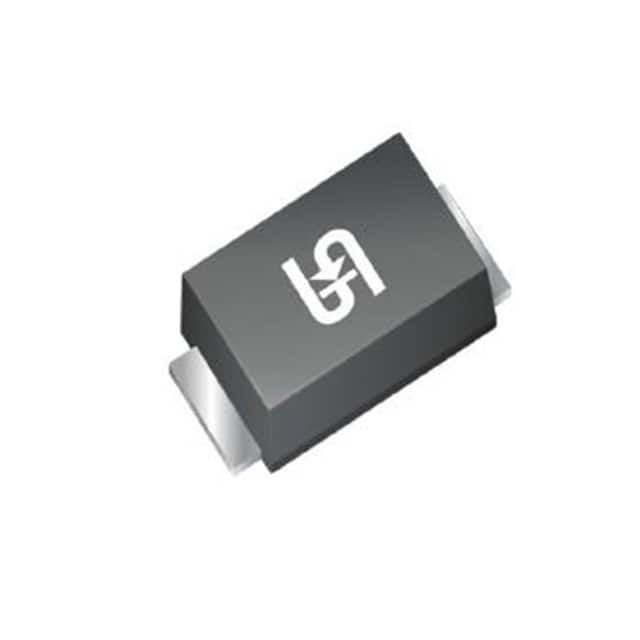Viz Specifikace pro podrobnosti o produktu.

S1AL RTG
Product Overview
S1AL RTG is a specialized component belonging to the category of semiconductor devices. It is commonly used in electronic circuits for its unique characteristics and functional features. The product comes in a compact package and is essential for various applications in the field of electronics.
Category
Semiconductor Devices
Use
S1AL RTG is used as a rectifier diode in electronic circuits to convert alternating current (AC) to direct current (DC).
Characteristics
- Efficient rectification of AC to DC
- Compact package design
- High reliability and durability
- Low forward voltage drop
Package
The S1AL RTG is typically packaged in a small, surface-mount package for easy integration into electronic circuit designs.
Essence
The essence of S1AL RTG lies in its ability to efficiently convert AC to DC, making it an essential component in various electronic applications.
Packaging/Quantity
The product is usually available in reels containing a specific quantity, such as 3000 units per reel.
Specifications
- Maximum Forward Voltage: 1V
- Maximum Reverse Voltage: 100V
- Maximum Forward Current: 1A
- Operating Temperature Range: -55°C to 150°C
Detailed Pin Configuration
The S1AL RTG has a standard pin configuration with two terminals for connection in electronic circuits. The pinout is as follows: - Pin 1: Anode - Pin 2: Cathode
Functional Features
- Efficient rectification of AC to DC
- Low forward voltage drop for minimal power loss
- Fast switching capability
Advantages
- High efficiency in converting AC to DC
- Compact size for space-constrained designs
- Reliable performance under varying operating conditions
Disadvantages
- Limited maximum forward current compared to higher-rated diodes
- Sensitive to reverse voltage spikes
Working Principles
S1AL RTG operates based on the principle of semiconductor junction behavior, allowing current to flow in one direction while blocking it in the opposite direction. When connected in a circuit, it effectively converts the incoming AC signal to a smooth DC output.
Detailed Application Field Plans
S1AL RTG finds extensive use in various electronic applications, including: - Power supplies - Battery chargers - LED lighting systems - Consumer electronics
Detailed and Complete Alternative Models
- S1BL RTG
- S1CL RTG
- S1DL RTG
These alternative models offer similar rectification capabilities with slight variations in specifications and package designs, providing flexibility in circuit design and application requirements.
In conclusion, S1AL RTG serves as a crucial component in electronic circuits, offering efficient rectification of AC to DC with its compact design and reliable performance. Its application spans across diverse electronic systems, making it an indispensable part of modern electronic designs.
[Word Count: 443]
Seznam 10 běžných otázek a odpovědí souvisejících s aplikací S1AL RTG v technických řešeních
What is S1AL RTG?
- S1AL RTG stands for "Single-Axis Linear Resistive Transducer Gauge," which is a type of sensor used to measure linear displacement or position.
How does S1AL RTG work?
- The S1AL RTG works by using a resistive element that changes resistance as the position changes, allowing it to measure linear displacement accurately.
What are the typical applications of S1AL RTG?
- S1AL RTG is commonly used in industrial automation, robotics, automotive systems, and aerospace applications for precise position sensing.
What are the advantages of using S1AL RTG in technical solutions?
- Some advantages of using S1AL RTG include high accuracy, reliability, durability, and suitability for harsh environments.
Are there any limitations to using S1AL RTG?
- One limitation of S1AL RTG is its sensitivity to electromagnetic interference, which may require additional shielding in certain applications.
How do I calibrate an S1AL RTG sensor?
- Calibration of an S1AL RTG sensor typically involves setting the zero position and adjusting the output signal to match the actual displacement.
Can S1AL RTG sensors be used in hazardous environments?
- Yes, S1AL RTG sensors are often designed to meet specific industry standards for use in hazardous environments, such as those with explosive atmospheres.
What are the different output options for S1AL RTG sensors?
- S1AL RTG sensors can have analog voltage, current, or digital outputs, providing flexibility for integration into various control systems.
How do I troubleshoot S1AL RTG sensor issues?
- Troubleshooting S1AL RTG sensor issues may involve checking for wiring faults, ensuring proper grounding, and verifying the input signal to the control system.
Are there alternative technologies to S1AL RTG for position sensing?
- Yes, alternative technologies include optical encoders, magnetostrictive sensors, and capacitive sensors, each with their own advantages and limitations.

